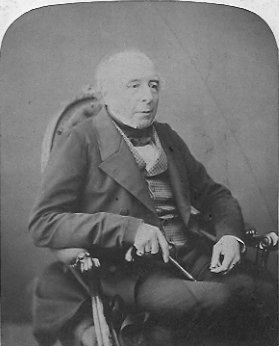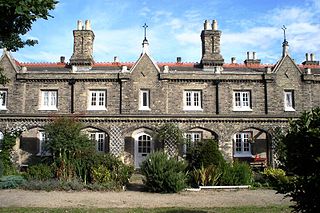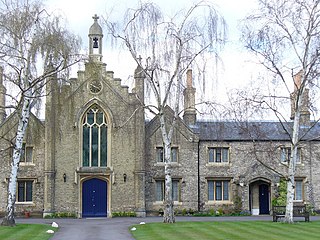
Bermondsey is a district in southeast London, part of the London Borough of Southwark, England, 2.5 miles (4.0 km) southeast of Charing Cross. To the west of Bermondsey lies Southwark, to the east Rotherhithe and Deptford, to the south Walworth and Peckham, and to the north is Wapping across the River Thames. It lies within the historic county boundaries of Surrey. During the Industrial Revolution Bermondsey became a centre for manufacturing, particularly in relation to tanning. More recently it has experienced regeneration including warehouse conversions to flats and the provision of new transport links.

Penge is a suburb of South East London, England, now in the London Borough of Bromley, 3.5 miles (5.6 km) west of Bromley, 3.7 miles (6.0 km) north east of Croydon and 7.1 miles (11.4 km) south east of Charing Cross.

Sir George Gilbert Scott, largely known as Sir Gilbert Scott, was a prolific English Gothic Revival architect, chiefly associated with the design, building and renovation of churches and cathedrals, although he started his career as a leading designer of workhouses. Over 800 buildings were designed or altered by him.

Philip Hardwick was an English architect, particularly associated with railway stations and warehouses in London and elsewhere. Hardwick is probably best known for London's demolished Euston Arch and its twin station, the original Birmingham Curzon Street, which stands today as the oldest railway terminus building in the world.

The Company of Watermen and Lightermen (CWL) is a historic City guild in the City of London. However, unlike the city's other 111 livery companies, CWL does not have a grant of livery. Its meeting rooms are at Waterman's Hall on St Mary at Hill, London.

Sir Arthur William Blomfield was an English architect. He became president of the Architectural Association in 1861; a Fellow of the Royal Institute of British Architects in 1867 and vice-president of the RIBA in 1886. He was educated at Trinity College, Cambridge, where he studied Architecture.
Samuel Sanders Teulon was an English Gothic Revival architect, noted for his use of polychrome brickwork and the complex planning of his buildings.
Bermondsey was a parish in the metropolitan area of London, England.

The Worshipful Company of Parish Clerks is one of the Guilds of the City of London. It has no livery, because "in the 16th century, the Parish Clerks declined to take the Livery on the grounds that the surplice was older than the Livery and was the proper garb of members of the Company." It is not, therefore, technically a livery company although to all intents and purposes it acts as such. It is one of two such historic companies without livery, the other being the Company of Watermen and Lightermen.

St John Horsleydown was the Anglican parish church of Horsleydown in Bermondsey, South London. Built for the Commission for Building Fifty New Churches to the designs of Nicholas Hawksmoor and John James in 1726–1733, it was noted for its distinctive spire in the form of a tapering column.

St Mary Magdalen Bermondsey is an Anglican church dedicated to St Mary Magdalen in Bermondsey in the London Borough of Southwark. The majority of the present building is late 17th century and is Grade II* listed.
Joseph Clarke (1819–1888) was a British Gothic Revival architect who practised in London, England.
Edwin Nash was an English Victorian ecclesiastical architect active in mid-nineteenth-century Kent, England. Most of his commissions were churches. He worked with architect John Nash Round on St. John the Evangelist, Penge (1850). Thereafter he worked alone. He proposed Joseph Fogerty to be a Fellow of the Royal Institute of British Architects.

The Free Watermen and Lightermen's Almshouses on Beckenham Road / Penge High Street, Penge, London Borough of Bromley were built in 1840–1841 to designs by the architect George Porter by the Company of Watermen and Lightermen of the City of London for retired company freemen and their widows. It is the most prominent and oldest of the Victorian almshouses in Penge. In 1973, the almspeople were moved to a new site in Hastings, and the original buildings were converted into private homes. They have been Grade II listed since 1973.
James Savage (1779–1852) was a British architect, based in London. His works included the Richmond Bridge in Dublin, and St Luke's Church, Chelsea, a pioneering work of the Gothic Revival. He was architect to the Honourable Society of the Middle Temple, and carried out restoration work at Lincoln Cathedral and St Mary-le-Bow. In 1836 he published a pamphlet in which he attacked the slavish imitation of historical styles.

John Rolls of The Hendre was a native of Bermondsey, in Southwark, London, Surrey, England. A member of the renowned Rolls family of The Hendre at Llangattock-Vibon-Avel near Monmouth, Monmouthshire, Wales, he undertook the first of several expansions of the mansion. The Hendre was also the childhood home of his great-grandson Charles Stewart Rolls, aviation pioneer and co-founder of Rolls-Royce Limited. John Rolls was a Justice of the Peace, as well as a Lieutenant Colonel of the Loyal Southwark Volunteer Infantry.
John Rolls was a native of Bermondsey, Southwark, London, Surrey, England. A member of the Rolls family of The Grange in Bermondsey and The Hendre, Monmouthshire, he married heiress Sarah Coysh. That marriage was instrumental in furthering both the fortune and the social rank of the Rolls family. In addition to serving a term as High Sheriff of Monmouthshire, Rolls was a Justice of the Peace.

Hickey's Almshouses are almshouses between Sheen Road and St Mary's Grove in Richmond, London.
Samuel Angell was a British architect and archaeologist.











